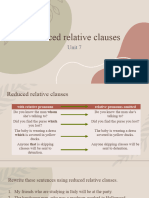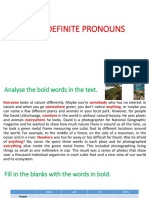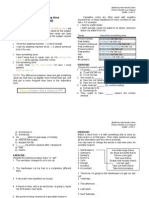0 ratings0% found this document useful (0 votes)
76 viewsPresent Perfect Continuous Tense
Present Perfect Continuous Tense
Uploaded by
ashikahmariamThe document discusses the differences between the present perfect simple and present perfect continuous tenses. It notes that both tenses can be used to talk about situations that started in the past and continue to the present or have just finished. However, the present perfect continuous focuses on extended actions that may be ongoing, while the present perfect simple focuses on completed actions with present results. Examples are provided to illustrate the different uses of the two tenses.
Copyright:
© All Rights Reserved
Available Formats
Download as PPTX, PDF, TXT or read online from Scribd
Present Perfect Continuous Tense
Present Perfect Continuous Tense
Uploaded by
ashikahmariam0 ratings0% found this document useful (0 votes)
76 views2 pagesThe document discusses the differences between the present perfect simple and present perfect continuous tenses. It notes that both tenses can be used to talk about situations that started in the past and continue to the present or have just finished. However, the present perfect continuous focuses on extended actions that may be ongoing, while the present perfect simple focuses on completed actions with present results. Examples are provided to illustrate the different uses of the two tenses.
Original Description:
Simple presentation
Copyright
© © All Rights Reserved
Available Formats
PPTX, PDF, TXT or read online from Scribd
Share this document
Did you find this document useful?
Is this content inappropriate?
The document discusses the differences between the present perfect simple and present perfect continuous tenses. It notes that both tenses can be used to talk about situations that started in the past and continue to the present or have just finished. However, the present perfect continuous focuses on extended actions that may be ongoing, while the present perfect simple focuses on completed actions with present results. Examples are provided to illustrate the different uses of the two tenses.
Copyright:
© All Rights Reserved
Available Formats
Download as PPTX, PDF, TXT or read online from Scribd
Download as pptx, pdf, or txt
0 ratings0% found this document useful (0 votes)
76 views2 pagesPresent Perfect Continuous Tense
Present Perfect Continuous Tense
Uploaded by
ashikahmariamThe document discusses the differences between the present perfect simple and present perfect continuous tenses. It notes that both tenses can be used to talk about situations that started in the past and continue to the present or have just finished. However, the present perfect continuous focuses on extended actions that may be ongoing, while the present perfect simple focuses on completed actions with present results. Examples are provided to illustrate the different uses of the two tenses.
Copyright:
© All Rights Reserved
Available Formats
Download as PPTX, PDF, TXT or read online from Scribd
Download as pptx, pdf, or txt
You are on page 1of 2
Differences between the Present Perfect Simple
and Present Perfect Continuous
We can use both the tenses above to talk about
situations that started in the past and are still continuing
and also about situations that have just finished but still
affect the present.
However, there are two main differences between the
two tenses which are:
The focus is the action of baking
Focus
itself and thinking of it as an
extended action that may have not
finished yet.
Example: Shes been baking cakes all afternoon
The focus is now on
the five cakes that
have already been
baked.
Example: Shes baked five cakes this afternoon.
Present perfect continuous tense is used to speak about situations
and actions that are more temporary, and the present perfect simple
tense is used for situations and actions that are more permanent.
Example:
The cat has been sleeping all day.
The cat has never caught any rats.
Who has been eating my chocolates? There are only a few bars left in
the fridge.
Who has eaten my chocolates? There are none left.
You might also like
- Features of Writing - Part 2Document20 pagesFeatures of Writing - Part 2Uang KejuNo ratings yet
- Modal Verbs Grammar Drills - 14575Document8 pagesModal Verbs Grammar Drills - 14575Janet HillNo ratings yet
- Obligation and Permisison in The PresentDocument22 pagesObligation and Permisison in The PresentamalNo ratings yet
- 6C Grammar Bank YMDocument2 pages6C Grammar Bank YMКароліна СеменкоNo ratings yet
- Swim Swimming: What Is A Gerund?Document3 pagesSwim Swimming: What Is A Gerund?alina solcanNo ratings yet
- Week 12 - Do The Right Thing!.ppsxDocument25 pagesWeek 12 - Do The Right Thing!.ppsxVíctor VargasNo ratings yet
- Modals in The Present and PastDocument3 pagesModals in The Present and PastMargot MontoyaNo ratings yet
- Reduced Relative ClausesDocument7 pagesReduced Relative ClausesBiiNo ratings yet
- Imaginary Situations in The Past With IfDocument3 pagesImaginary Situations in The Past With IfReneeNo ratings yet
- Presnet Simple and Present ContinuousDocument2 pagesPresnet Simple and Present Continuousjhostin mundacaNo ratings yet
- Verbs of Attribution: Going Beyond "So-And-So Says "Document2 pagesVerbs of Attribution: Going Beyond "So-And-So Says "Swapna KumariNo ratings yet
- Australian English Kel 2 Kelas BDocument22 pagesAustralian English Kel 2 Kelas BTeo mahatmana Ksatria Mukti100% (1)
- Politician Reported SpeechDocument21 pagesPolitician Reported SpeechAngelitos SinfinNo ratings yet
- Gerunds and InfinitivesDocument3 pagesGerunds and InfinitivesDiana RiveraNo ratings yet
- W14 - Passive VoiceDocument3 pagesW14 - Passive VoiceMichael Damian Triana PerezNo ratings yet
- Present Simple Vs Present Continuous (Oral Ex.)Document3 pagesPresent Simple Vs Present Continuous (Oral Ex.)kakashylechkaNo ratings yet
- Simple Past Vs Present Perfect (2nd)Document19 pagesSimple Past Vs Present Perfect (2nd)Gina RosaliaNo ratings yet
- Past Perfect HandoutDocument1 pagePast Perfect HandoutAiram AlfatherNo ratings yet
- Prefix, Root, SuffixDocument15 pagesPrefix, Root, SuffixdinejedidahNo ratings yet
- Present Perfect - For and SinceDocument10 pagesPresent Perfect - For and SinceCompumaster ECNo ratings yet
- Present Perfect Simple & ContinuousDocument19 pagesPresent Perfect Simple & Continuousvishalsharma1745644100% (1)
- Passive VoiceDocument19 pagesPassive VoiceSururul HafizhahNo ratings yet
- Reduced Relative ClausesDocument14 pagesReduced Relative ClausesgamzeNo ratings yet
- Past Simple Vs Present PerfectDocument12 pagesPast Simple Vs Present PerfectKattyPérezNo ratings yet
- C1 - Unit 4 - Class 1 - Future Tenses - WorksheetDocument2 pagesC1 - Unit 4 - Class 1 - Future Tenses - WorksheetMai Xuân TiếnNo ratings yet
- 3 - Indefinite PronounsDocument10 pages3 - Indefinite PronounsBurakhan ŞeyhoğluNo ratings yet
- CBATELP GERUNDS AND INFINITIVES-Summary ChartDocument1 pageCBATELP GERUNDS AND INFINITIVES-Summary ChartAna Jessica Acha MendietaNo ratings yet
- Inversion in Conditional SentencesDocument29 pagesInversion in Conditional SentencesJhon Leonidas Condori RamosNo ratings yet
- ConditionalsDocument25 pagesConditionalsCamila BalcazaNo ratings yet
- Reported SpeechDocument11 pagesReported Speechapi-29163702050% (2)
- Change Is The Only Thing Constant in The World. - The World Is Not Black and White - We Are All in Constant MotionDocument30 pagesChange Is The Only Thing Constant in The World. - The World Is Not Black and White - We Are All in Constant Motionperlishell74No ratings yet
- Past Tense 2Document23 pagesPast Tense 2Dicky CandRaNo ratings yet
- Conditionals and Mixed ConditionalsDocument26 pagesConditionals and Mixed ConditionalsElian Ramirez100% (1)
- Gerunds and InfinitivesDocument14 pagesGerunds and InfinitivesLeonardo DannyNo ratings yet
- First ConditionalDocument10 pagesFirst ConditionalMiguel Ángel100% (1)
- 8 - Consumerism - Passive Voice PDFDocument3 pages8 - Consumerism - Passive Voice PDFSandra Brás Pereira50% (2)
- Get Have Something DoneDocument2 pagesGet Have Something DoneSara Balderas100% (1)
- Second Conditional "If Type 2": If + Simple Past, + Would InfinitiveDocument8 pagesSecond Conditional "If Type 2": If + Simple Past, + Would InfinitiveCeren AçıkelNo ratings yet
- Used To Be Used To Get Used ToDocument8 pagesUsed To Be Used To Get Used ToHerbert OsorioNo ratings yet
- Y YyyDocument13 pagesY YyyKuroyami 翼 GamiNo ratings yet
- Used To, Get Used ToDocument7 pagesUsed To, Get Used ToJorge CardozaNo ratings yet
- Unreal Past & Conditionals Type 3Document3 pagesUnreal Past & Conditionals Type 3Mei Li TreNo ratings yet
- VERB TO BE (Simple Present)Document3 pagesVERB TO BE (Simple Present)JOSE SEBASTIAN VERGARA CERANo ratings yet
- Indefpronouns 121002045306 Phpapp02Document18 pagesIndefpronouns 121002045306 Phpapp02Jose MaciasNo ratings yet
- Workbook 2Document1 pageWorkbook 2English PlanetNo ratings yet
- Zero and First Conditionals, and Future TimeDocument7 pagesZero and First Conditionals, and Future TimeangelesNo ratings yet
- Impersonal PassiveDocument2 pagesImpersonal PassiveYulivia CórdobaNo ratings yet
- Passive Voice TestDocument2 pagesPassive Voice TestNazar Meyer100% (1)
- Quantifiers: Much, Many, Little, FewDocument5 pagesQuantifiers: Much, Many, Little, FewDai KaitoNo ratings yet
- Reporting Verbs: Learning GuideDocument4 pagesReporting Verbs: Learning GuidebobNo ratings yet
- Ielts Writing Table Task 1 GraphsDocument1 pageIelts Writing Table Task 1 GraphsDulce MoonNo ratings yet
- ConditionalsDocument3 pagesConditionalsLilithGypsy100% (1)
- Defining Relative ClausesDocument15 pagesDefining Relative ClausesJoao Paulo SilvaNo ratings yet
- Redicates and UantifiersDocument44 pagesRedicates and Uantifiersedniel maratasNo ratings yet
- Present Perfect Vs Simple PastDocument14 pagesPresent Perfect Vs Simple Past7angyg8No ratings yet
- Theory - I Wish - If OnlyDocument1 pageTheory - I Wish - If OnlylamanandaNo ratings yet
- Present Perfect Vs Simple PastDocument14 pagesPresent Perfect Vs Simple PastLudivia PaolaNo ratings yet
- Passive VoiceDocument24 pagesPassive Voiceadara17No ratings yet
- Present Perfect Simple Vs ContinuousDocument7 pagesPresent Perfect Simple Vs ContinuousElif OzdamarNo ratings yet
- Present Perfect and Present ContinousDocument15 pagesPresent Perfect and Present Continousfiras ahmedNo ratings yet
- Proposal SampleDocument40 pagesProposal SampleashikahmariamNo ratings yet
- Hanafin & PeckDocument30 pagesHanafin & PeckashikahmariamNo ratings yet
- Ex OutputDocument2 pagesEx OutputashikahmariamNo ratings yet
- Search Product Filter By: Brand Price Products Swatch Dkny MK Adida S FossilDocument12 pagesSearch Product Filter By: Brand Price Products Swatch Dkny MK Adida S FossilashikahmariamNo ratings yet
- It Was The Queens From The Buckingham Palace Where in Accordance in Tradition The Flag Was There Which Provoked Public Anger. ADocument1 pageIt Was The Queens From The Buckingham Palace Where in Accordance in Tradition The Flag Was There Which Provoked Public Anger. AashikahmariamNo ratings yet
- Num Name Colour Price (RM) ImageDocument2 pagesNum Name Colour Price (RM) ImageashikahmariamNo ratings yet
- Aodifrsm: Analyse Analyse Objective Objective Maintenance MaintenanceDocument4 pagesAodifrsm: Analyse Analyse Objective Objective Maintenance MaintenanceashikahmariamNo ratings yet
- Group A: SGDR 1013 Introduction To LiteratureDocument18 pagesGroup A: SGDR 1013 Introduction To LiteratureashikahmariamNo ratings yet
- Journal ReviewDocument6 pagesJournal ReviewashikahmariamNo ratings yet
- Num Name Colour Price (RM) ImageDocument2 pagesNum Name Colour Price (RM) ImageashikahmariamNo ratings yet
- Five Comic Strips: (Individual Assignment)Document1 pageFive Comic Strips: (Individual Assignment)ashikahmariamNo ratings yet
- Title (Individual Assignment) : CollageDocument1 pageTitle (Individual Assignment) : CollageashikahmariamNo ratings yet
- Social Network DisadvantageDocument1 pageSocial Network DisadvantageashikahmariamNo ratings yet








































































